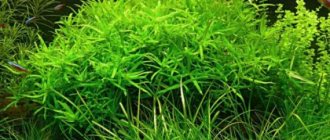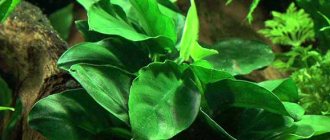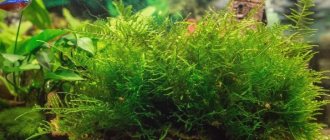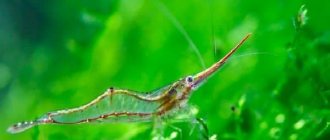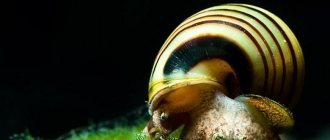Not all representatives of aquatic flora with decorative beauty are in particular demand among aquarists. For a long time, a plant called Blixa japonica has been neglected. The situation changed when Japanese aquarium designer Takashi (Takashi) Amano gave a vivid presentation of this inhabitant of the underwater world, glorifying its amazing beauty. Since then, the popularity of blixa has only grown.
Read more: the world of Takashi Amano, a Japanese aquarium designer. For a long time, Blyxa japonica was not as popular as other aquarium algae.
Description and characteristics
The scientific name of Japanese blyxa, or blyxa japonica, is Blyxa japonica (or Blyxa japonica var. Japonica).
In nature, this hygrophyte grows into dense thickets of medium height. Fish hide in them from danger, and some species use them for spawning.
Aquarium plant Blixa japonica
It is mostly an ornamental plant. Looks great in both volume and nano aquariums. There are a huge number of options for leaf colors and bush shapes, depending on the environment.
It has a medium-thick root system in order to gain a foothold on the substrate. The option of free swimming on the surface of the reservoir is possible.
It happens that a single branch of japonica, rooted in the ground, holds several lateral branches due to dense thickets. Moreover, floating specimens also feel great.
About reproduction
You can tell when Blix can be replanted by the presence of basal side shoots. This is essentially a new young plant, but without an independent root system.
After carefully cutting such a shoot with scissors, the cuttings can be planted separately.
Important: inspect it carefully for rotting particles or simply bad leaves. They may subsequently play a role in the development of disease processes.
Transplanting to a new location is stressful for the plant. Situations are described when it simply dissolved in water. If rooting does not occur immediately (or you missed the moment when the bush floated to the surface), its base loses the ability to absorb nutrients and becomes slimy. Such a process has no chance of survival. If possible, it is worth breaking off the diseased part and trying to root the healthy tip.
Natural habitat
The growing area of japonica is very extensive. This tropical inhabitant can be found in shallow and fresh water bodies of the following areas:
- India;
- countries of Southeast Asia;
- Pacific archipelagos;
- Japan;
- islands of New Guinea.
Blixa japonica in nature
The main habitats include:
- ponds;
- rice fields;
- lakes;
- streams;
- coastal strips of large bodies of water;
- small marshy ponds;
- irrigation canals;
- weak-flowing rivers enriched with iron;
- ditches.
Under natural growth conditions, it is equally unpretentious to both bright sun and shaded conditions.
Transfer
Over time, the Japanese blixa ages, its lower leaves fall off, and the trunk becomes bare by about a third. To restore the plant to its former attractiveness, you need to carefully trim the trunk under the lower leaves and remove the lower half with roots from the soil. The upper part of the bush should be dug into the ground. In a few days, the bush will take root and safely continue its development.
ATTENTION: If Japonica is adjacent to ground cover plants, then when transplanted, it can lift up part of the green mat with its roots. To keep the carpet intact, you need to cut the blixa at the root. True, this will have to be done regularly, since new shoots may come from the roots.
Return to content
Appearance
Blixa japonica is a long-stemmed plant with closely spaced leaves, which makes it look like a compact bush-ball.
The height of the stem can be up to 12 cm, width - 0.5 cm. The leaves are linear, 3-5 mm wide, 6-10 cm long, tapering towards the tip. Depending on the habitat, the color of the leaf blade varies from light green to golden red. Occasionally, the leaves curl up at the tips, making the plant even fluffier.
Requirements for water composition
Blixa japonica is demanding on the composition of water. It develops best under the following conditions:
- temperature from 22°C to 28°C;
- softness 8-12 units;
- acidity 5.5-7.2 units;
- changing 20-25% of water every 2 weeks;
- regular supply of CO2;
- high-quality filtration.
ATTENTION! Deviation of the softness and acidity of water from normal values can lead to a change in the shape and color of the bush, as well as the death of the leaves and root system of the plant.
Return to content
Content
Breeding blix grass in aquarium conditions is of average difficulty. She is classified as a moderately demanding type.
The following criteria will be optimal:
- water with a temperature of 23-28 °C;
- water hardness - 4–10 °dGH;
- pH value - 5.5–7.5;
- feeding with fertilizers;
- illumination level - medium or high;
- powerful filtration;
- changing a quarter of the water in the aquarium every week;
- increase in carbon dioxide concentration.
These parameters are also suitable for many tropical and heat-loving species of aquarium fish, which are recommended for living near japonica. If the inhabitants neighboring it are less thermophilic, the temperature in the aquarium can be slightly reduced, although the growth and development of the hygrophyte will slow down.
Japonica requires silted nutrient soil: coarse sand or fine gravel. Under good conditions, it forms dense grass “lawns” in the aquarium.
Coarse sand for aquarium
Due to the special fragility of the stem and leaves, it is not recommended to keep it together with herbivorous fish.
Blixa is quite relaxed about direct sunlight and short-term lack of filtration. But you shouldn't test her endurance.
Reproduction and planting
Propagated by dividing side shoots, which grow quite easily from the rhizome. Over time, they grow aerial roots. Carefully separate a cutting with several roots from the mother stem and plant it in fertilized soil. A fairly fragile young stem should be carefully sprinkled with soil so as not to damage it.
Cuttings for planting
Monitor the shoot for several days after planting. It weakly clings to the ground and can float up. We'll have to plant it again. With a soil layer thickness of 3-5 cm and a sufficient amount of nutrients, the young stem will quickly take root and take root.
The planting density should be 2-3 plants per 20 square meters. cm.
Before planting, you should carefully inspect the cuttings to see if there are rotting leaves on it. Because of them, diseases can develop in the newly planted plant.
Lighting
Lighting in the aquarium should be kept moderate. For this, fluorescent lamps are used at the rate of 0.3-0.5 W per 1 liter of water volume. Daylight hours for blixa should last 10-12 hours a day.
In low light, the leaf blades acquire a bright green color, and the plant stretches, reaching its maximum height. But it still remains decoratively attractive.
Fluorescent lamps provide optimal illumination for blix
The increased intensity of light gives them a reddish-golden color, especially if orange-red rays predominate in the emission spectrum of the illumination source.
Dwarf blixa is the name given to those representatives of japonica whose height barely reaches 6-7 cm. The plant is so compact due to strong lighting.
Top dressing
Blyxa japonica grows well in soil rich in organic matter, especially nitrogen. Such root feeding is important for reliable rooting and giving strength to the leaves.
Both root feeding and liquid fertilizers should be applied. After all, Blyxa is able to feed not only with the help of roots, but also through leaf plates. Sapropel and clay saturate the plant with carbon dioxide through the root system. It becomes lush and bright.
Organic fertilizers enhance the lushness and brightness of the color of blix
Root feeding is required during the period of planting cuttings.
In an aquarium populated with fish, Japonica will be able to fully develop due to sufficient natural siltation.
If iron-containing fertilizers are added, the leaf blades will turn blood red. On the contrary, a lack of iron will color the plant green. Even increasing the lighting (1 W per liter of water) will not help restore the color.
Japanese Blixa is able to grow well even without saturating the water with iron and fluorides.
Clay or bottom silt of a fresh reservoir can be used as fertilizers. They contain a lot of humus and plankton, which are useful for the growth of transplanted plants. But such feeding is dangerous because natural sludge can contain parasites that are harmful to the plant.
Stem pruning
As the plant grows, it sheds its leaves at the bottom of the stem. A bare stem does not decorate the aquarium landscape.
To maintain the attractiveness of the blix bush, it is necessary to periodically cut off the fluffy part of the stem and replant it in the same way as cuttings. Only in this case, the pruned plant must still grow roots. The remaining root must be carefully pulled out and removed from the aquarium.
Landing
Using scissors, you need to separate the side shoots. To avoid damaging the plant, you need to act carefully, since the roots of the shoots are very fragile. You need to make a hole in the ground and put a piece of red clay in it. The root of the shoot is placed in the hole and covered with soil. It is better to crush the soil near the stem a little to compact it, otherwise the planted plant may float.
The soil for planting should be 3-4 cm thick. And be sure to ensure that the planted shoots do not float up.
Diseases
Clean water is the key to the balanced existence of the plant and its healthy appearance.
With a lack of minerals and carbon dioxide, with a light deficiency, and also in high alkaline and hard water, the growth of Japanese blyx slows down, the color of the leaves turns pale, and the lower leaves generally fall off.
Fading and thinning of leaf blades are signs of japonica disease
Japonica can become infected with diseases from poor-quality water, contaminated soil, or from sick fish.
For preventive purposes, before planting blyx in the aquarium, the water should be treated with disinfectants specially designed for this purpose, and newly acquired fish should be kept in quarantine.
Fading and thinning of the leaf blades and rotting of the plant may indicate a hygrophyte disease. The best option is to remove infected specimens from the aquarium to avoid spreading diseases to other plants.
Stem pruning
The arrangement of the leaves of Japanese Blixa is associated with some nuances of caring for the plant. The stem from which the leaf blades extend grows, although at a slow speed, but continuously. Because of this, the rosette at the base of the bush gradually rises higher and higher above the ground. At the same time, another process occurs - the lower leaves, having outlived their term, die off and thereby expand the bare space on the stem.
From time to time, the stem of the blyxa begins to be visible above the ground; for a neat appearance of the aquarium, it is necessary to replant the plant
The leafless, thick stem begins to be conspicuous and thus degrades the overall appearance of the aquarium vegetation. To maintain the blixa in normal condition and maintain the attractiveness of the created composition, it is necessary to replant the plant from time to time (as the stem grows), removing excess length in the process. To do this correctly, you need to:
- carefully trim the stem, slightly retreating from the lower leaves;
- remove the bare stem from the soil along with the root system;
- replant the cut rosette into the substrate.
Further actions do not differ from the process of initially planting the plant. You need to make sure that the blixa does not float to the water surface. And when it acquires a root system and strengthens itself in the soil, support it with fertilizers and organic matter.
Using Blyxa in an Aquascape
In aquadesign, Japanese blixa is used both as a single bush and as a whole group. As the main focus of the design, it is placed in the center, and climbing species are planted around. It turns out tender and beautiful, like an oasis of living energy.
If they want to focus attention on other plants, for example, with towering stems, then blixa can picturesquely fill the space between separately located stones and snags.
Blixa can serve as a link between the background and foreground. It is used to create backgrounds in nanoaquariums. It all depends on the preferences of the aquadesigner. By arranging the light differently, planting blixa in pots or bowls decorated with interior elements, they create unique underwater compositions.
Aquasape using Blixa
In aquadesign Blyxa japonica var. Japonica is harmoniously combined with Hemianthus cuba, Elatina pepper, Java moss and other “carpet” crops.
In aquariums with Blixa, it is recommended to place schooling fish with bright colors, such as neons, thornets, tetras, etc. They will look even more colorful and impressive against a lush green background.
Blixa japonica stands out from other ornamental aquarium plants: a miniature, compact plant with an amazing variety of color tones, useful for aquarium inhabitants. The conditions of detention are quite acceptable. With a little effort, you can enjoy the aesthetics and uniqueness of your aquarium design.
Interesting plant? Have you seen him live? Share your opinions and impressions in the comments.
